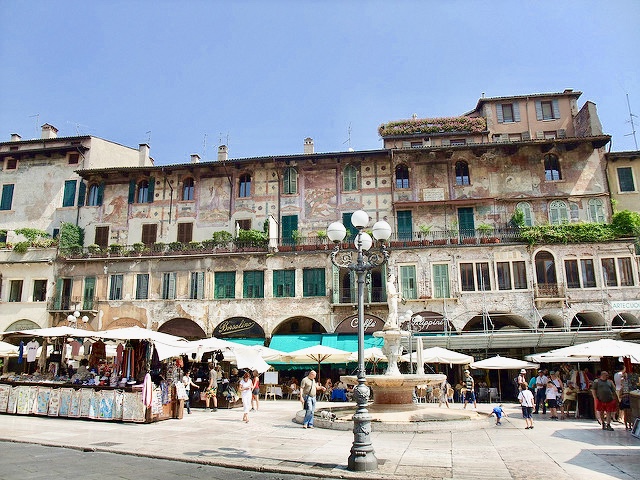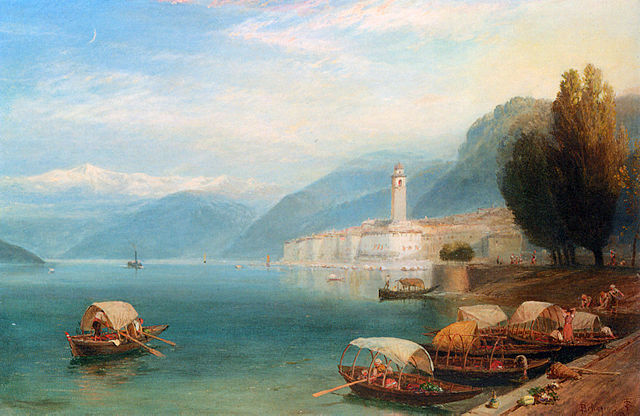Verona
Day 9 includes a visit to the historic town of Verona.
Read Verona's History
 |
| Take a tour - "Verona in 4K" |
Verona will be our stop on the bus ride to Venice. Some of us may choose to sit at a cozy cafe and soak in the 2,000 years of history, while others of us may want to explore every inch of the city that time allows. There will be something for everyone in Verona.
The Arch Scaligeri
A group of five tombs honor the Scaligeri family who ruled Verona from the 13th to late 14thC. The most celebrated of the family is Cangrande, a great warrior, prince and patron of the arts.
Congrande is Italian for "Big Dog".
Castle Vecchio
The red brick castle and bridge crossing the Adige River was built by Cangrande ll. Known as the "old castle", its most distinguishing features are the red brick M-shaped merlons. Today it is a museum.
Piazza Bra
Upon arriving we will enter Piazza Bra, the heart of the city. "Bra" means broad, and this piazza's pink marbled walkways are packed with a mix of cozy street bars, cafes, medieval city walls, statues and palaces. It is one of the largest piazzas in Europe.
The Arena
At the heart of Piazza Bra is its claim to fame - the Verona Arena. The Roman amphitheater from 30 AD was so famous for the ludi - the shows and gladiator games - that spectators came from far and wide. The third largest arena in Italy, it can seat 25,000 spectators on 44 tiers of marble seats. The facade we see is actually just the original internal support for the tiers. Only a fragment of the original outer perimeter wall of white and pink limestone remains due to an earthquake in 1117. The interior is virtually intact and is used for many events - theatre, operas and fairs.
Porta Borsari
This archway is the facade from a 3rd-century gate in the original Roman city walls. Corso Cavour, the road passing through the arches, is the original Via Sacra - the main entrance to the city. An inscription is dated 245AD. It got its name from the "bursary" paid to the Roman soldiers who stood guard.
Piazza delle Erbe
Originally a Roman forum with a long history of trading, it is lined with old merchants' houses, palaces, towers and statues. It has been called "the painted city" for its beautiful frescoed facades. In the square is Torre dei Lamberti, an 84m-tall watchtower from the 12thC. One can ride 2/3rds of the way up and walk the rest for a panoramic view of the city and surrounding mountains. As for the large hanging whale's rib in the square, legend says it will fall on the first person who dares to walk under it.
Juliet's Balcony
Did the Capulet family really live here? Or is this house in Verona billed as "Juliet's Balcony" covered in fairy dust? Shakespeare's Juliet wasn't based on a real person, and the house in Verona that some claim to be her house has no connection to the story. However, throngs of people visit it daily, leave love notes, and caress the right breast of her sculpture to bring good luck in love.
Verona Duomo
There is a small fee to tour the interior of this beautiful cathedral.
You can take a 3-D tour here. https://youtu.be/fyW-riZDvUk
The Ponte Pietra
This stone wall bridge from 100 BC crosses over the Adige River. It provided the villagers living on the right bank access to the Roman Theatre on the other side of the river.
Roman Theatre
The theatre was built in the 1st century BC. Eventually falling in disuse, it was later filled in and built upon to provide needed housing. In the 18th C a wealthy Veronese bought all of those houses and removed them in order to unearth the theatre. It is still used for summer musicals,
and the setting provides splendid views of the city.
Photo credits in order:
10.














Comments
Post a Comment